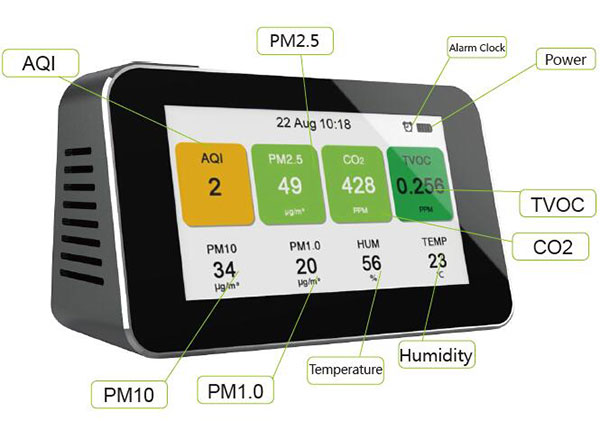How to Maintain Air Quality Monitor?
Air pollution mainly comes from haze, dust particles, smoke, automobile exhaust, second-hand smoke, soot, and so on. Indoor air pollutants are mainly from decoration, because the widely-used decorative materials, plates, paint, glue, new furniture, adhesives, etc., easily produce harmful pollutants to human health. Indoor air quality monitors can detect the dust particles PM2.5 in the air, and also detect the formaldehyde and TVOC produced by decoration. Air pollution is very harmful to the human body, so a reliable air quality monitor can help you detect the air pollution index at home, and offer comprehensive protection to pregnant women, children, the elderly, and family members. Maintaining an air quality monitor is crucial to ensure accurate and reliable measurements. Here are some general guidelines to help you maintain an air quality monitor.
Regular Calibration and Keep Clean
Regular calibration is essential for maintaining the accuracy of an air quality monitor. Follow the manufacturer's instructions to calibrate the sensors, ensuring precise readings. Adhere to the recommended calibration schedule provided by the manufacturer to guarantee consistent performance.
In addition to calibration, it's crucial to keep the monitor clean. Use a soft, dry cloth to remove dust, dirt, and contaminants from external surfaces. Be cautious and avoid using harsh chemicals or liquids that may harm the sensors or the monitor itself.
Check for obstructions around the air intake and exhaust vents of the monitor. Unrestricted airflow is vital for accurate sensor readings. Ensure there are no physical barriers that could impede the monitor's proper functioning. This proactive approach helps maintain the reliability of the air quality monitor and ensures it operates optimally in measuring air quality.

Power Supply and Software Updates
To safeguard the functionality of your air quality monitor, it is crucial to consider environmental factors and power supply considerations. Firstly, protect the monitor from adverse environmental conditions by placing it in a location shielded from extreme temperatures, high humidity, direct sunlight, and potential water exposure. For monitors positioned outdoors, employ weatherproof enclosures to enhance protection against the elements.
Additionally, ensure a stable and reliable power supply for the air quality monitor. Regularly check the battery level if the device operates on batteries and promptly replace or recharge as necessary. Adhere to the manufacturer's recommendations concerning power requirements to maintain uninterrupted and accurate monitoring.
Stay proactive in ensuring the monitor's optimal performance by keeping its firmware or software up to date. Regularly check for updates provided by the manufacturer, as these may include important bug fixes and enhancements. By staying current with firmware/software updates, you contribute to the long-term effectiveness and reliability of your air quality monitoring system.

Regular Inspections
To ensure the effectiveness of your air quality monitoring system, it is essential to focus on data management, sensor longevity, and regular inspections. Begin by meticulously recording the data collected by the monitor and routinely analyzing it for trends or unusual patterns. Promptly investigate any sudden changes or anomalies in the data to identify potential issues and address them proactively.
Additionally, be attentive to sensor replacement, as certain air quality monitors are equipped with sensors that have a limited lifespan. Adhere to the manufacturer's guidelines for sensor replacement and replacement sensors as recommended to uphold accuracy in the monitoring results.
Conduct regular inspections of the air quality monitor to identify any physical damage or signs of wear. Address identified issues promptly to prevent further damage and ensure continuous, reliable performance. Verify that connections and cables are secure and in good condition during these inspections, as proper connectivity is crucial for accurate data collection. By incorporating these practices into your maintenance routine, you contribute to the longevity, precision, and overall reliability of your air quality monitoring system.
Follow Manufacturer Guidelines
Adhering to the manufacturer's guidelines is paramount for the proper care and maintenance of your air quality monitor. Always consult the user manual and follow the provided guidelines for specific maintenance instructions and recommendations. The manufacturer's instructions typically include essential information on calibration procedures, sensor replacement schedules, and other critical maintenance tasks. In case you encounter any challenges or have questions related to the maintenance of your air quality monitor, do not hesitate to reach out to the manufacturer's customer support. Their expertise can provide valuable insights, troubleshooting assistance, and guidance on resolving any issues you may encounter. By following the manufacturer's guidelines and seeking support when needed, you ensure that your air quality monitor operates optimally and continues to provide accurate and reliable data.
In summary, remember that proper maintenance is essential for the accurate functioning of air quality monitors. Regular checks and adherence to the manufacturer's recommendations will contribute to the reliability of the data collected. ATO online shop provides you with high-quality products, and we have professional engineers to answer your questions and provide assistance. If you have any inquiries, feel free to contact us at any time.

